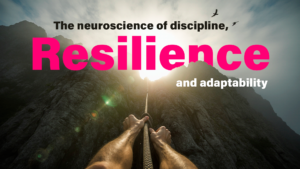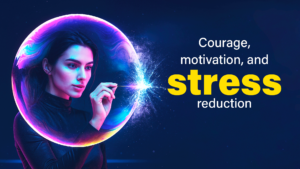
Discover the cognitive cost of automation in the workplace.
In today’s hyper-automated corporate environment, AI chatbots like ChatGPT have become essential for streamlining workflows, improving customer service, and generating reports. But while these tools boost productivity, they also present hidden risks. A recent study published in Frontiers in Psychology reveals that the overuse of AI may lead to Artificial Intelligence Chatbot–Induced Cognitive Atrophy (AICICA) — a phenomenon that closely parallels what neuroscience applied to stage fright has shown about stress-induced mental performance decline.
This article explores how over-reliance on AI can erode cognitive agility — the brain’s ability to think critically, creatively, and independently — and what business leaders can do to preserve their organization’s most valuable asset: the human mind.
The Neuroscience Behind Delegation and Cognitive Decline
Modern neuroscience has repeatedly shown that skills not practiced deteriorate, much like muscles left unused. The same applies to mental functions. According to Adamopoulou et al. (2024), frequent users of AI chatbots may experience weakened memory, lower critical thinking skills, and overdependence on machine-generated solutions. This phenomenon mirrors findings in neuroscience applied to stage fright, where heightened stress or overreliance on cues leads to cognitive inhibition and poor performance.
In corporate settings, this creates a dangerous paradox. While automation accelerates operations, delegating too much to AI risks diminishing the very abilities that made executives successful in the first place — judgment, strategic thinking, and innovation.
Case Study: When Automation Backfires
In 2023, a tech startup implemented AI to draft pitches, analyze competitors, and summarize market data. Initially, productivity soared. But within six months, the leadership team noticed a stark decline in ideation quality and analytical depth. Employees began to wait for chatbot-generated suggestions instead of brainstorming ideas themselves.
As observed in Harvard Business Review, the absence of cognitive effort led to stagnation. The judgment calls that once fueled the company’s edge were now passively outsourced — a textbook case of AICICA in action.
How Neuroscience Informs Cognitive Preservation in the Workplace
Research in neuroscience applied to stage fright reveals that under-stimulated cognitive pathways weaken over time, much like stage performers who lose their edge when over-scripted. Business professionals are no different. To prevent cognitive atrophy, it’s crucial to challenge the brain regularly — even amid technological advancement.
Five Brain-Based Strategies to Sustain Mental Agility
- AI-Free Days for Executive Functions
Set specific days where teams must complete strategic tasks without using AI tools. This re-engages memory recall, analytical reasoning, and decision-making. - Human-Led Creative Brainstorming Sessions
Resist the urge to prompt chatbots. Instead, conduct idea sessions where participants must rely on their own insights and group dynamics to generate value. - Critical Thinking Drills
Before accepting any AI-generated output, require manual evaluation of alternatives. Ask: Is this logic sound? What assumptions are at play? What would I do differently? - Peer Review Without Tech Assistance
Encourage teams to review reports and strategy proposals without digital support. Real-time human feedback activates deeper thinking and emotional intelligence. - Cognitive Performance Audits
Integrate KPIs that track independent thought, idea originality, and contribution during meetings. Reward mental engagement, not just task completion.
How Young Professionals Are Especially Vulnerable
The study also warns that younger professionals, still in the process of developing their executive and analytical skills, are especially at risk. If their first exposure to problem-solving comes via automation, they may never fully cultivate key mental abilities.
This should concern both managers and HR teams. While AI is a powerful onboarding tool, it must not replace the mental “training ground” necessary for long-term leadership development.
Current Trends and AI-Driven Self-Regulation
Interestingly, some AI platforms are starting to recognize these cognitive risks. New versions of popular chatbots now offer usage reports, warnings on over-dependence, and even recommendations for user engagement outside the platform.
Simultaneously, digital mindfulness and neurometric tools like CogniFit, Elevate, and NeuroNation offer ways to monitor and improve mental performance. These platforms align perfectly with neuroscience-backed methods for regaining focus, memory, and mental resilience.
Future-Proofing Cognitive Strength in AI-Driven Enterprises
As we integrate AI into everyday business processes, leaders must take an active role in designing systems that support both automation and mental agility. The most successful executives of tomorrow will be those who embrace AI without sacrificing human insight.
By recognizing the signs of cognitive decline, implementing routine brain-training strategies, and promoting a culture of active thinking, companies can avoid the silent erosion of their intellectual capital.
Conclusion: Let AI Assist — Not Replace — Your Thinking
Artificial intelligence is a powerful ally, but it should not become a crutch. When AI takes over critical thinking, creativity suffers, and competitive advantage diminishes. Organizations must resist the allure of total automation and instead create environments where human insight is not just valued — it’s exercised daily.
Build your company into a hub of innovation, not dependency. In a world of identical tools, your people’s thinking is what will set you apart.
Reference
Adamopoulou, E., Moussiades, L., & Bai, S. (2024). From tools to threats: A reflection on the impact of artificial-intelligence chatbots on cognitive health. Frontiers in Psychology, 15, 1259845. https://doi.org/10.3389/fpsyg.2024.1259845
Continue reading more articles: https://neurobusiness.us/blog/


